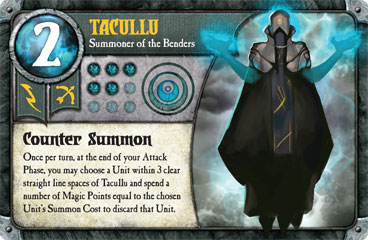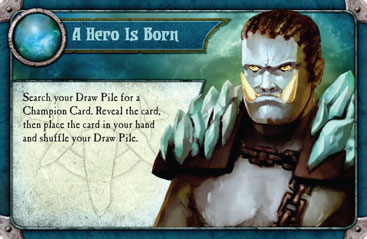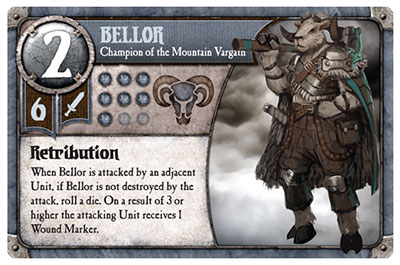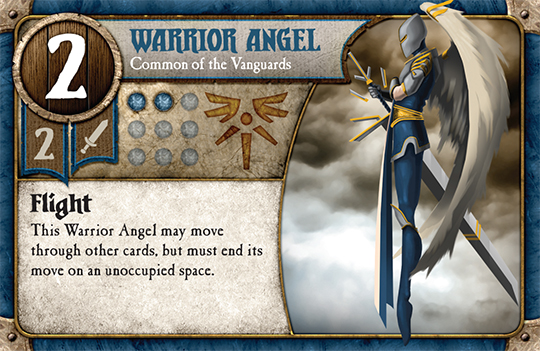What is Summoner Wars?
Summoner Wars is a tactical board game best played with two players, but is expandable to four players. The best way I can describe it in one line is "Chess meets Magic the Gathering." It is played on a 6x8 grid board (see above.) Each player must select a faction to play with (there are 16 different factions currently.) Each faction has its own deck and starting setup. The starting setup will include your summoner, a wall, and a few common units. Over the course of the game you take turns drawing up to five cards, summoning new units, playing event cards (more on these later,) moving, and attacking the enemy units. Anytime that you destroy an enemy unit or wall, it gets sent to your magic pile and can be used to pay for summoning new units later in the game. You may also discard any amount of cards from your hand at the end of your turn and place them in your magic pile.
Each movement phase you can move up to three units and each unit can move up to two spaces. You cannot move diagonally. Each attack phase you may attack with up to three units. When you attack with a unit, you roll the number of dice shown in the big circle in the top left of the card. When you roll, each result of a 1 or 2 is a miss, and every result of 3 or higher is a hit and deals a wound. Ranged units can shoot up to three, clear, straight spaces away, so you can't shoot through other cards. You also cannot move through other cards, including your own. If you run out of cards to draw, you have to continue playing with whats left until someone wins.
Now that you know the basics of what you will be doing on your turns, lets look at the different types of cards you will be using.
Your summoner is like your king in chess. If he dies at any point you instantly lose the game. All units starting life are marked by a number of dots near the middle of the card. Tacullu (above) is the summoner for the Bender faction. He starts with five life as shown by the dots on the card. He rolls two dice when he attacks, as shown by the large 2 in the upper left corner of his card. The two symbols under the attack value represent the cost to summon the unit, and if the unit is a ranged attacker or melee. Since Tacullu is a summoner you never have to pay to summon him to the board (because he starts out, and if he ever dies you have lost the game.) Instead of a cost number the little lightning bolt is a reminder that Tacullu is a summoner. The bow and arrow symbol means Tacullu is a ranged attacker, a sword would indicate that he is a melee attacker.
The wall cards are your summoning points. When you summon new units into the game they must be played next to a wall that you control. Think of the walls as your forts, both protecting your summoner from fire, and allowing you to sally out with new units. Your walls are not invincible. They have nine life which is high but walls will still die quickly if you allow them to be focused on. If you do not have a wall on the board you cannot summon any new units until you play a new one.
An event card is a card that you may play for free from your hard, invoking some sort of effect or special ability. Each summoner has his or her own set of event cards and they all allow you to do various cool things, such as deal damage directly to units, summon units for free, move enemy walls, or event take control of enemy units!
Champions are high cost units that can smash through enemy armies. They tend to have higher attack, and much higher life than most common units. You may only have three champion units in your deck. Bellor (above) is a six cost champion with seven life, and he gets a chance to hit back anytime someone attacks him. Almost every faction wants to get at least one champion out per match, and some factions attempt to get all three out.
The last type of card is the commons. Common units are the meat of your army. Every faction gets to start with a handful of common units on the board at the beginning of the game. You are allowed to have 18 commons in your deck, including the ones that start on the board. Because some factions start with more or less units on the board at the start of the game, the amount of cards that start in your deck may vary slightly. But, over the course of the game both players have the same amount of commons to use. This Warrior Angel (above) is a common of the Vanguards. He has two attack as shown on the large shield in the upper left, and costs two magic cards (shown on the small banner) from your magic pile to place into play. Like all other units he must be placed next to a wall you control. His special ability lets him fly over other cards (this includes walls) which is very useful.
That concludes my overview post on how to play Summoner Wars. I find the game very addicting, and while it is simple to learn, it is hard to master. If you are interested enough in the game to give it a try, I recommend buying the Master Set. It contains six different faction decks that you can play with and are not found in any other set. It also comes with a hard board instead of the paper play mat that the older starter sets come with. I find that the six factions in the Master Set are some of the most fun to play, and they are all considered to be very strong factions.
I hope this post satisfied your thirst for summoner wars knowledge! If you have any more questions be sure to comment.






No comments:
Post a Comment